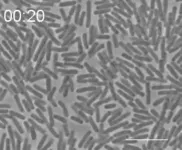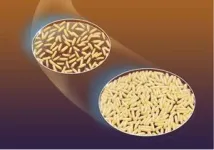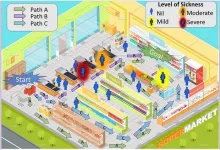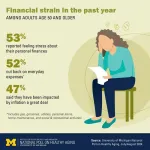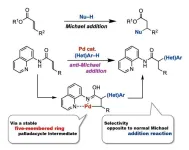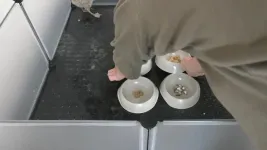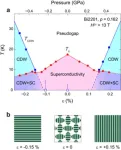(Press-News.org) Dense E.coli bacteria have several similar qualities to colloidal glass, according to new research at the University of Tokyo. Colloids are substances made up of small particles suspended within a fluid, like ink for example. When these particles become higher in density and more packed together, they form a “glassy state.” When researchers multiplied E.coli bacteria within a confined area, they found that they exhibited similar characteristics. More surprisingly, they also showed some other unique properties not typically found in glass-state materials. This study contributes to our understanding of glassy “active matter,” a relatively new field of materials research which crosses physics and life science. In the long term, the researchers hope that these results will contribute to developing materials with new functional capabilities, as well as aiding our understanding of biofilms (where microorganisms stick together to form layers on surfaces) and natural bacterial colonies.
What do butter, soap and ink all have in common? They certainly don’t all taste good, but they are all types of colloids, substances made of particles suspended in fluid. When the concentration of particles is low, then the substance will be more liquid, and when it is high, then it becomes more solid (think of a dried-out inkwell). When this happens, the substance enters a glassy state, whereby the movement of the particles is restricted. However, although it may feel hard, unlike with other solids, the particles do not form fixed patterns but are jumbled together randomly. This is similar to the molecular structure of glass.
Researchers have now found that the bacteria E. Coli can behave in a similar way. “Since bacteria are very different from what we know of as glass, it was surprising that many of the statistical properties of glassy materials were the same for bacteria,” said Associate Professor Kazumasa Takeuchi from the Department of Physics at the Graduate School of Science. “However, the bigger surprise for us was that in-depth analysis revealed not only a similarity to the standard properties of glass, but also other properties beyond that. Our results call for an extension of our current understanding of the physics of glass.”
Takeuchi was inspired to carry out the experiment after observing the behavior of bacteria in a different study over 10 years ago. At that time, he saw that when a population of bacteria became very dense, it abruptly stopped moving and he wanted to understand why.
The main challenge was to create an environment in which the bacteria could equally thrive and multiply to form a dense population. To achieve this, the team used a device they had previously developed, which enabled them to equally distribute nutrients through a porous membrane to all the bacteria. The researchers then observed the bacteria by microscope over 5-6 hours.
As the number of E.coli increased, they became caged in by their neighbors, restricting their ability to swim freely. Over time, they transitioned to a glassy state. This transition is similar to glass formation, as the researchers noted a rapid slowdown of movement, the caged-in effect and dynamic heterogeneity (whereby molecules travel longer distances in some areas but hardly move in others).
What made this bacterial glass different to other glasslike substances was the spontaneous formation of “microdomains” and the collective motion of the bacteria within these areas. These occurred where groups of the rod-shaped E.coli became aligned the same way. The researchers were also surprised that the way the bacteria vitrify (turn into a glasslike state) apparently violates a physical law of typical thermal systems. What we characteristically know as glass, including colloidal glass, is classed as thermal glass. However, recently researchers have started to explore glassy states, like the one reported in this paper, which aren’t considered thermal glass but share many of the same properties.
“Collections of ‘self-propelled particles’ like we see here have recently been regarded as a new kind of material called active matter, which is currently a hot topic and shows great potential,” explained Takeuchi. “Our results on bacterial glass are along this line of research, extending this concept to the realm of glassy materials. In the long term, our results might contribute to developing novel materials with some functions that are impossible with ordinary materials.”
Next the team wants to explore how this phenomenon plays out with other diverse species of bacteria in different environments. Ongoing research has so far shown that there are different ways in which cells can become crowded together. Takeuchi said: “Our results indicate that dense bacteria can drastically change their mobility and mechanical properties at the population level, by a minute change in the cell density. This information could be used to regulate or control dense bacteria formations in the future. Through our work, we hope to make deeper and broader connections between statistical physics and life science.”
#####
Paper
Hisay Lama, Masahiro J. Yamamoto, Yujiro Furuta, Takuro Shimaya, and Kazumasa A. Takeuchi. Emergence of bacterial glass. PNAS Nexus. 11th July 2024. DOI: 10.1093/pnasnexus/pgae238
Funding
This research was supported in part by KAKENHI from Japan Society for the Promotion of Science (Grant Nos. JP16H04033, JP19H05800, JP20H00128, JP21K20350, JP24K00593), by Core-to-Core Program “Advanced core-to-core network for the physics of self-organizing active matter (JPJSCCA20230002), and by “Planting Seeds for Research” program and Suematsu Award from Tokyo Institute of Technology.
Conflicts of interest
None.
Useful Links
Graduate School of Science: https://www.s.u-tokyo.ac.jp/en/index.html
Department of Physics: https://www.phys.s.u-tokyo.ac.jp/en/
Research contacts
Associate Professor Kazumasa Takeuchi
Department of Physics
Graduate School of Science,
The University of Tokyo, 7-3-1 Hongo,
Bunkyo-ku, Tokyo, 113-0033, Japan
Email: takeuchi@phys.s.u-tokyo.ac.jp
Press contact
Mrs. Nicola Burghall (she/her)
Public Relations Group, The University of Tokyo,
7-3-1 Hongo, Bunkyo-ku, Tokyo 113-8654, Japan
press-releases.adm@gs.mail.u-tokyo.ac.jp
About the University of Tokyo
The University of Tokyo is Japan’s leading university and one of the world’s top research universities. The vast research output of some 6,000 researchers is published in the world’s top journals across the arts and sciences. Our vibrant student body of around 15,000 undergraduate and 15,000 graduate students includes over 4,000 international students. Find out more at www.u-tokyo.ac.jp/en/ or follow us on X (formerly Twitter) at @UTokyo_News_en.
END
Bacteria form glasslike state
Densely packed E.coli form an immobile material similar to colloidal glass
2024-07-11
ELSE PRESS RELEASES FROM THIS DATE:
Prestigious MERIT grant funds research on how the immune system can banish HIV
2024-07-11
Weill Cornell Medicine has received $4.2 million to study how the immune system in some people infected with HIV can keep the virus under control, which could lead to novel therapeutic strategies for thwarting or eliminating HIV. Dr. Brad Jones, associate professor of immunology in medicine in the Division of Infectious Diseases at Weill Cornell Medicine, was awarded a MERIT grant from the National Institute for Allergy and Infectious Diseases (NIAID) at the National Institutes of Health (NIH).
The “Method for Extending Research in Time” (MERIT) grant provides ...
Research reveals novel CARS E795V mutation as cause of inherited Parkinson's disease
2024-07-11
According to Science Alert, neuroscientists from Johns Hopkins University have recently discovered a new treatment for Parkinson's disease using an FDA-approved cancer drug. A recent study published in Neuroscience Bulletin reveals the genetic cause of Parkinson's disease. The study discovered that a mutation in the Cysteinyl-tRNA synthetase (CARS) gene (c.2384A>T; p.Glu795Val; E795V) is responsible, offering a new path for prevention and control of the disease. This research was conducted by a team led by Zhang Jianguo, including researcher ...
Narcissism decreases with age, study finds
2024-07-11
People tend to become less narcissistic as they age from childhood through older adulthood, according to a study published by the American Psychological Association. However, differences among individuals remain stable over time -- people who are more narcissistic than their peers as children tend to remain that way as adults, the study found.
“These findings have important implications given that high levels of narcissism influence people’s lives in many ways -- both the lives of the narcissistic individuals themselves and, maybe even more, the lives of their families and friends,” said lead author Ulrich Orth, PhD, of the University of Bern in Switzerland.
The ...
Scientists call for ‘major initiative’ to study whether geoengineering should be used on glaciers
2024-07-11
A group of scientists have released a landmark report on glacial geoengineering—an emerging field studying whether technology could halt the melting of glaciers and ice sheets as climate change progresses.
The white paper represents the first public efforts by glaciologists to assess possible technological interventions that could help address catastrophic sea-level rise scenarios.
While it does not endorse any specific interventions, it calls for a “major initiative” in the next decades to research which, if any, interventions could and should be ...
Mount Sinai secures over $4 million grant from National Institutes of Health to study alopecia areata and atopic dermatitis in people with Down Syndrome
2024-07-11
New York, NY (July 11, 2024) – The Icahn School of Medicine at Mount Sinai is embarking on biomedical research aiming to set new standard-of-care protocols for treating alopecia areata and atopic dermatitis in people with Down syndrome, or trisomy 21.
Emma Guttman-Yassky, MD, PhD, the Waldman Professor and Chair of Dermatology at Icahn Mount Sinai, has been awarded more than $4 million for a five-year National Institutes of Health (NIH) R61/R33 grant to evaluate the long-term safety, efficacy, and mechanisms of medications known as JAK inhibitors in patients with Down syndrome. The medications have been approved ...
How risk-averse are humans when interacting with robots?
2024-07-11
How do people like to interact with robots when navigating a crowded environment? And what algorithms should roboticists use to program robots to interact with humans?
These are the questions that a team of mechanical engineers and computer scientists at the University of California San Diego sought to answer in a study presented recently at the ICRA 2024 conference in Japan.
“To our knowledge, this is the first study investigating robots that infer human perception of risk for intelligent decision-making in everyday settings,” said Aamodh Suresh, first author of the study, who earned his Ph.D. in the research group of Professor Sonia Martinez Diaz ...
An unequal toll of financial stress: Poll of older adults shows different impacts related to health and age
2024-07-11
Inflation rates may have cooled off recently, but a new poll shows many older adults are experiencing financial stress – especially those who say they’re in fair or poor physical health or mental health.
Women and those age 50 to 64 are more likely than men or people over age 65 to report feeling a lot of stress related to their personal finances. So are people age 50 and older who say they’re in fair or poor physical or mental health.
In all, 47% of people age 50 and older said inflation had impacted them a great deal in the past year, and 52% said they ...
One-step synthesis of pharmaceutical building blocks: new method for anti-Michael reaction
2024-07-11
In 1887, chemist Sir Arthur Michael reported a nucleophilic addition reaction to the β-position of α,β- unsaturated carbonyl compounds. These reactions, named Michael addition reactions, have been extensively studied to date. In contrast, the anti-Michael addition reaction, referring to the nucleophilic addition reaction to the α-position, has been difficult to achieve. This is due to the higher electrophilicity of the β-position compared to the α-position. Previous attempts to overcome these difficulties have involved two main methods. The first is restricting the addition position via intramolecular reactions, ...
Urban seagulls still prefer seafood
2024-07-11
Seagull chicks raised on an “urban” diet still prefer seafood, new research shows.
University of Exeter scientists studied herring gull chicks that had been rescued after falling off roofs in towns across Cornwall, UK.
Raised in captivity (before being released), they were given either a “marine” diet consisting mainly of fish and mussels, or an “urban” diet containing mostly bread and cat food.
Every few days the gull chicks were presented with a choice of all four foods in different bowls, to test which they preferred – and all gulls strongly favoured fish.
“Our results suggest that, even when reared on an ‘urban’ ...
Understanding the origin of superconductivity in high-temperature copper oxide superconductors
2024-07-11
Superconductors are materials that can conduct electricity with zero resistance when cooled to a certain temperature, called the critical temperature. They have applications in many fields, including power grids, maglev trains, and medical imaging. High-temperature superconductors, which have critical temperatures higher than normal superconductors have significant potential for advancing these technologies. However, the mechanisms behind their superconductivity remain unclear.
Copper oxides or cuprates, a class of high-temperature superconductors, exhibit superconductivity ...
LAST 30 PRESS RELEASES:
SIMJ announces global collaborative book project in commemoration of its 75th anniversary
Air pollution exposure and birth weight
Obstructive sleep apnea risk and mental health conditions among older adults
How talking slows eye movements behind the wheel
The Ceramic Society of Japan’s Oxoate Ceramics Research Association launches new international book project
Heart-brain connection: international study reveals the role of the vagus nerve in keeping the heart young
Researchers identify Rb1 as a predictive biomarker for a new therapeutic strategy in some breast cancers
Survey reveals ethical gaps slowing AI adoption in pediatric surgery
Stimulant ADHD medications work differently than thought
AI overestimates how smart people are, according to HSE economists
HSE researchers create genome-wide map of quadruplexes
Scientists boost cell "powerhouses" to burn more calories
Automatic label checking: The missing step in making reliable medical AI
Low daily alcohol intake linked to 50% heightened mouth cancer risk in India
American Meteorological Society announces Rick Spinrad as 2026 President-Elect
Biomass-based carbon capture spotlighted in newly released global climate webinar recording
Illuminating invisible nano pollutants: advanced bioimaging tracks the full journey of emerging nanoscale contaminants in living systems
How does age affect recovery from spinal cord injury?
Novel AI tool offers prognosis for patients with head and neck cancer
Fathers’ microplastic exposure tied to their children’s metabolic problems
Research validates laboratory model for studying high-grade serous ovarian cancer
SIR 2026 delivers transformative breakthroughs in minimally invasive medicine to improve patient care
Stem Cell Reports most downloaded papers of 2025 highlight the breadth and impact of stem cell research
Oxford-led study estimates NHS spends around 3% of its primary and secondary care budget on the health impacts of heat and cold in England
A researcher’s long quest leads to a smart composite breakthrough
Urban wild bees act as “microbial sensors” of city health.
New study finds where you live affects recovery after a hip fracture
Forecasting the impact of fully automated vehicle adoption on US road traffic injuries
Alcohol-related hospitalizations from 2016 to 2022
Semaglutide and hospitalizations in patients with obesity and established cardiovascular disease
[Press-News.org] Bacteria form glasslike stateDensely packed E.coli form an immobile material similar to colloidal glass
